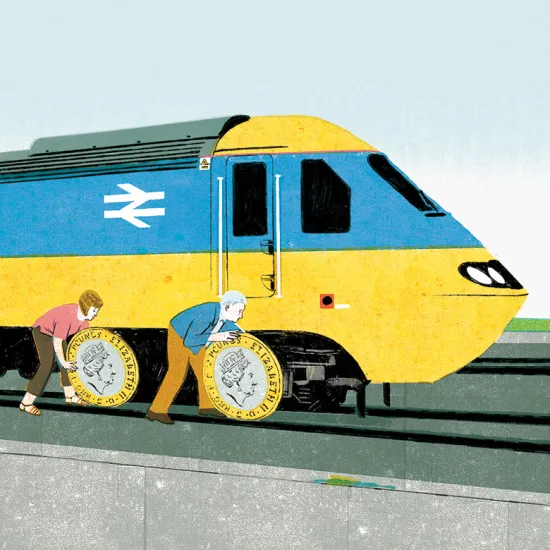Peak rush hour is a good time to gauge the mood of Britons traveling to and from work on the country’s decrepit trains. Social media will tell all you need to know: delays; cancellations; and dirty, cramped conditions. But commuters have little choice.
When the U.K.’s railways were on the cusp of privatization, the public was sold a very different outcome.
“The best way to produce profound and lasting improvements on the railways is to end British Rail’s state monopoly,” the Conservative Party’s 1992 manifesto said.
“For the first time ever performance targets will be set, widely published, and rigorously monitored; fare levels will reflect the standards set; and discounts will be paid to regular travelers where performance targets are not met,” the right-leaning party vowed. “We want to restore the pride and local commitment that died with nationalization.”
The Tories would go on to win the election, and privatization followed between 1994 and 1997.
Prime minister John Major’s government planned for private investors to fund new rolling stock and that operators would seek out the best trains to compete against one other. It didn’t pan out that way.
Since 1995 annual rail tickets have more than doubled in price. Long-distance fares rose by 151 percent since privatization, on average, according to the 2017 U.K. government rail fares index. Commuter fares in London were up 106 percent. These figures are in real terms, adjusted for inflation, according to the U.K. government’s Office of Rail and Road.
Regular travelers are still waiting on those long-promised discounts for enduring subpar rail performance.
Critics have claimed that shareholder dividends of the train operating companies are partly to blame, as are the high costs of leasing trains from rolling stock companies, or “Roscos.”
After privatization, the three main U.K. Roscos — Angel Trains, Eversholt Rail Group, and Porterbrook Leasing Co. — were initially majority-owned by banks.
Nomura Holdings initially owned Angel, before Royal Bank of Scotland bought it in 1997. That same year HSBC picked up Eversholt, which had spent a brief period in private equity ownership. Abbey National, later part of Santander Group, eventually acquired Porterbrook.
“Pre-2010, it was very much a bank-owned market,” explains Tom Sumpster, head of infrastructure finance at Legal & General Investment Management. “It evolved post the financial crisis into an asset class where longer-term investors wanted to invest.” Investment managers became part owners of these rail businesses.
“Institutional investors just weren’t really there precrisis,” says Sumpster. “It started growing as a credible market in which to start transactions in 2012, and in the past few years, we have seen a move towards engaging with institutional investors at the first port of call.”
Regulatory changes partly explain this trend. As banks quit the market in a response to new regulation such as the Basel III Accord, which required more capital to back risky loans, institutional investors gained flexibility through the Solvency II Directive, among other rule packages.
The U.K. government had also become concerned about the Rosco oligopoly. Its Competition Commission investigated and in 2009 recommended offering longer franchise terms to operators like Abellio East Anglia and FirstGroup. Given 12- to 15-year contracts, the commission said, operators could “realize the benefits and recover the costs of switching to alternative new or used rolling stock over a longer period,” thus spurring competition among Roscos to serve the operators new trains. The government fully adopted the recommendations in the years that followed.
And at long last, train-operating companies have started to request fresh rolling stock.
In June 2017, Aviva Investors announced it would lend £1 billion ($1.38 billion) of pension fund cash to fund new trains for the companies running the U.K.’s South Western Railway franchise.
At the time, Daniel Hobson, senior investment manager of the Greater Manchester Pension Fund, called the project “an excellent example” of pension investors and the private sector working together for the national interest. “We are heavily reliant on our rail infrastructure,” Hobson said. “These upgrades will mean better passenger experience while at the same time helping to provide stable returns.”
Aviva’s was the first in a flurry of announcements of pension funds investing in rail rolling stock.
This winter Legal & General Investment Management’s real assets arm said it had sealed two deals to splash out £350 million on new trains for East Anglia and the West Midlands, having earlier committed £200 million to other similar projects.
“These two deals further expand LGIM’s clients’ exposure to essential infrastructure projects in the U.K., offering them long-term, stable cash flows and in both cases, alongside experienced infrastructure asset owners,” Tom Sumpster said in the January announcement. “This is great for business and great for our customers,” his colleague Hayley Rees added.
Planned government infrastructure projects such as High Speed Two (HS2) and the rebuilding of the Oxford-to-Cambridge Varsity Line further suggest that institutional investors will have significant opportunities in years ahead.
While this may provide little immediate comfort to beleaguered commuters, they at least have reason to be hopeful. Pension funds may just save the day.







